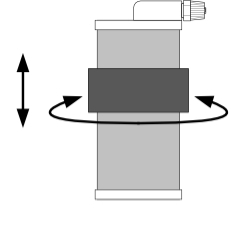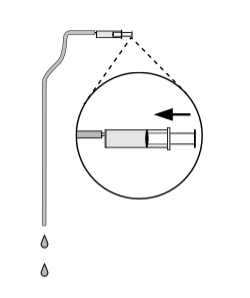The AQUA Logic Siphon Drinking Water Filter functioThe Siphon filter is a so-called Point of Use filter. This means that the water is treated where it is used. This minimizes the risk of contamination during the journey from source to user.
Emergency drinking water filter
This water filter is used worldwide in emergency and disaster situations where there is a lack of clean and safe drinking water. Disease caused by contaminated water is unfortunately the number 2 cause of death worldwide and even the number 1 cause of death among children up to 5 years old. Often more people die from the disaster after the disaster than from the disaster itself. With your purchase you support the work of the IBOTA Foundation and making this water filter available to those i
Aid and Relief
The Siphon filter is a simple and very compact drinking water filter that has been specially developed to give people who live in poor conditions access to clean and safe drinking water. For example, this filter is distributed by various aid agencies to families in disaster situations or underdeveloped areas.
Drinking water for the whole family
This little powerhouse can clean 10 liters per hour. It is super small and cheap to buy. This filter (if used correctly) can provide a family with clean and safe drinking water for a period of at least 1 year. Practice has shown that this can take up to several years, depending on the degree of contamination of the water source.
Backpackers
Are you on the road, through nature or abroad and do you doubt whether the tap water is drinkable? Even then this compact water filter is the solution.
Suitable Water Sources for Use with Our AQUA Logic Emergency Water Filters
- Rainwater: Easy to collect and directly filter.
- Surface Water: For example, from ditches, lakes, rivers, and streams.
Tip: For optimal results, we recommend pre-filtering surface water with a cloth, such as a tea towel, to remove large contaminants.
- Spring Water: Water from natural springs, if accessible.
- Snow and Ice: Melted snow or ice can be filtered.
Note: Do not use snow or ice that is contaminated with salt or has lost its clear white color.
- Groundwater: Water from shallow wells or boreholes.
Note: If the groundwater contains iron, it can be easily de-ironed by adding oxygen to the water. This can be done by pouring the water back and forth between two buckets. Allow the water to settle so that the iron particles accumulate at the bottom. The clear water on top can then be filtered with the AQUA Logic emergency water filter.
- Rain Puddles: Water collected in depressions after rainfall. Pre-filter large contaminants before filtering.
- Condensed Water: Water collected through condensation, such as with plastic sheets or collection systems.
Note: This filter is not suitable for purifying saltwater or heavily chemically contaminated water.
Groundwater and De-Ironing
Groundwater may contain iron, which can cause a metallic taste and discoloration. You can easily remove iron from the water before filtering it with the AQUA Logic emergency water filter. Follow these steps:
- Add Oxygen: Pour the groundwater back and forth between two buckets several times. This allows the water to absorb oxygen, oxidizing the iron.
- Let it Settle: Allow the water to sit for several hours so the oxidized iron particles settle at the bottom.
- Separate the Water: Carefully scoop or pour the clear water from the top into another bucket, leaving the iron particles at the bottom.
- Filter: The clear water is now ready to be filtered with the AQUA Logic emergency water filter.
This simple method works well for water with low to moderate iron content. For water with high iron levels, additional techniques or tools may be necessary.
Filter Characteristics 4-in-1 CS-Ultra Filter Element with Sediment Filter Sleeve
1. Activated carbon cylinder with a pore size of 1 micron.
Activated carbon is organic material (coconut shell) and has a very high adsorption capacity.
Activated carbon adsorbs odor, color and taste, metals such as lead, as well as molds, chlorine, medicine residue and other chemicals.
2. Nano Silver Impregnation
Colloidal (Nano) silver is applied to activated carbon. The Nano Silver coating inhibits the growth of bacteria and microorganisms in water, ensuring safer and cleaner drinking water. This effect is achieved because the Nano Silver particles disrupt the cell walls of microorganisms, hindering their reproduction and significantly reducing the risk of water contamination and the spread of pathogens. This antibacterial action makes this water filter highly suitable for situations with a high degree of contamination by microorganisms, such as Cholera.
3. Ultrafiltration membranes with a pore size of 0.01–0.03 micron
Ultrafiltration membrames providing effective filtration against:
- Pathogenic organisms: Bacterial reduction of >99.9999% (including Cholera, Shigella, Typhus, Klebsiella terrigena, Enterococci, Legionella, and E. coli)
- Cysts/Protozoa: (including Giardia and Cryptosporidium)
- Micro- and Nano-plastics: Removes particles as small as 0.03 microns (30 nanometers)
4. Sediment Filter Sleeve
The Sediment Filter Sleeve is very effective in filtering coarser contaminants in the water such as sand, mud and clay. The Filter Sleeve extends the life of the activated carbon and the ultrafiltration membranes, which will be less likely to clog.
All parts are BPA-Free. The filter works without the addition of chemicals and is made up of maintenance-free and corrosion-free parts.
How to Use
 1. Attaching the Hose
1. Attaching the Hose
Insert the hose into the swivel ring, then push the hose onto the filter outlet. Finally, secure the connection by tightening the swivel ring onto the outlet.
2. Using the Filter Sleeve
Always use the supplied Filter Sleeve to prevent clogging. Fit it around the filter and secure it tightly around the blue cap by pulling the cord firmly.
3. Placing and Preparing the Filter
Place the filter in a bucket of water at least 1 meter high. Submerge it completely – if needed, you can place a weight in the sleeve to keep the filter fully underwater.
4. Activating the Filter
Draw water through the outlet hose by using the supplied syringe. In the beginning only air is drawn into the syringe. Disconnect the syringe and push the air out of it. Repeat these steps until water starts flowing through and siphoning has started. If sufficient water is available, it is recommended to not use the first batch of filtered water (ca. 5 liter) for consumption. After that, the filter is ready to provide clean and safe drinking water.
Note 1: The Siphon drinking water filter can also be used if you don't have a bucket with you and are on the go.
- Hang the filter in (surface) water.
- Ensure the filter is saturated with water. This can be achieved by submerging it for a while with something heavy on top and/or by holding the filter underwater and using the included syringe to draw water into it.
- Suck on the end of the tube to filter the water and drink it immediately.
Note 2: You can accelerate filter saturation by slowly pushing filtered water back through the filter with the syringe.
5. Ready for Use
The filter is now ready. The hose can be closed by pressing the clip.
Maintenance
 Cleaning the Filter
Cleaning the Filter
If the water flow slows down, the filter can be cleaned easily:
- Remove the Filter Sleeve and rinse it thoroughly.
- Using the integrated Cleaning Pad, the filter surface can be sanded clean (see image beside).
- Rinse the actived carbon surface. Make sure only clean water touches the water outlet. As a precaution, do not use the first liter of filtered water for consumption.
- Backwashing: push back clean drinking water slowly back into the filter using the syringe.
 Cleaning the Hose
Cleaning the Hose
- Boil at least 300 ml of water.
- Detach the hose from the filter and connect the hose to the supplied syringe and place the hose (not the syringe) in the boiling water.
- Use the syringe to draw hot water through the hose and let it sit for 3 minutes.
- Use the syringe to draw hot water through the hose, then carefully push it back into the pan. Repeat 3 times.
Storage after Use
Wet Storage (1–4 weeks): Disassemble the filter element. Store it in a sealed container or bag, preferably in the refrigerator.
Dry Storage: Let the filter air-dry in a clean area. Drying near a heat source, such as a radiator or in sunlight, is recommended — but avoid direct contact between the heat source and the plastic parts, as this may cause damage.
Note: When the filter is put back into use, it may take some time before the water flows through properly. As a precaution, do not use the first liter of filtered water for consumption.
Optional precaution
For those who want to preventatively treat the filter element before storing it,
Cosil47 Water Filter Disinfectant is a complementary product. It can be used as follows:
- Fill the upper water reservoir with clean (preferably filtered) water.
- Add Cosil47 Colloidal Silver, following the instructions in the Cosil47 manual.
- Run the water through the filter element until it is completely saturated.
- You can then store the filter element wet or dry (see instructions above).
Shelf life and Life Span
Unused, the filter has an almost unlimited shelf life (store in a cool, dry and dark place). The adviced service life is 1 year; the actual lifespan of the filter element may vary depending on the degree of contamination in the source water. As long as water continues to flow through the filter, it is safe to drink, even if the flow rate decreases.
Disclaimer
This water filter is designed to reduce a wide range of contaminants to levels generally considered safe for daily use. However, it may not be effective against water heavily contaminated with industrial chemicals or hazardous substances. Although water quality is significantly improved, the filter is not intended for specialized or medical use. Individuals with weakened immune systems or specific health concerns are advised to take extra precautions and consult a professional if necessary.










